Probability Models
University of Amsterdam
2025-09-08
Why do we need them
Exact approach
Applicable
Exact probabilities can only be calculated for:
- Discreet variables
- Categorical variables
An exact approach lists and counts all possible combinations.
Coin values
Coin values for heads and tails.
\(\{1, 0\}\)
10 tosses
| Toss1 | Toss2 | Toss3 | Toss4 | Toss5 | Toss6 | Toss7 | Toss8 | Toss9 | Toss10 |
|---|---|---|---|---|---|---|---|---|---|
| 0.5 | 0.5 | 0.5 | 0.5 | 0.5 | 0.5 | 0.5 | 0.5 | 0.5 | 0.5 |
| 0.5 | 0.5 | 0.5 | 0.5 | 0.5 | 0.5 | 0.5 | 0.5 | 0.5 | 0.5 |
| 0.5 | 0.5 | 0.5 | 0.5 | 0.5 | 0.5 | 0.5 | 0.5 | 0.5 | 0.5 |
| 0.5 | 0.5 | 0.5 | 0.5 | 0.5 | 0.5 | 0.5 | 0.5 | 0.5 | 0.5 |
| 0.5 | 0.5 | 0.5 | 0.5 | 0.5 | 0.5 | 0.5 | 0.5 | 0.5 | 0.5 |
| 0.5 | 0.5 | 0.5 | 0.5 | 0.5 | 0.5 | 0.5 | 0.5 | 0.5 | 0.5 |
| 0.5 | 0.5 | 0.5 | 0.5 | 0.5 | 0.5 | 0.5 | 0.5 | 0.5 | 0.5 |
| Toss1 | Toss2 | Toss3 | Toss4 | Toss5 | Toss6 | Toss7 | Toss8 | Toss9 | Toss10 | probability |
|---|---|---|---|---|---|---|---|---|---|---|
| 0.5 | 0.5 | 0.5 | 0.5 | 0.5 | 0.5 | 0.5 | 0.5 | 0.5 | 0.5 | 0.0009766 |
| 0.5 | 0.5 | 0.5 | 0.5 | 0.5 | 0.5 | 0.5 | 0.5 | 0.5 | 0.5 | 0.0009766 |
| 0.5 | 0.5 | 0.5 | 0.5 | 0.5 | 0.5 | 0.5 | 0.5 | 0.5 | 0.5 | 0.0009766 |
| 0.5 | 0.5 | 0.5 | 0.5 | 0.5 | 0.5 | 0.5 | 0.5 | 0.5 | 0.5 | 0.0009766 |
| 0.5 | 0.5 | 0.5 | 0.5 | 0.5 | 0.5 | 0.5 | 0.5 | 0.5 | 0.5 | 0.0009766 |
| #Heads | frequencies | Probabilities |
|---|---|---|
| 0 | 1 | 0.0009766 |
| 1 | 10 | 0.0097656 |
| 2 | 45 | 0.0439453 |
| 3 | 120 | 0.1171875 |
| 4 | 210 | 0.2050781 |
| 5 | 252 | 0.2460938 |
| 6 | 210 | 0.2050781 |
| 7 | 120 | 0.1171875 |
| 8 | 45 | 0.0439453 |
| 9 | 10 | 0.0097656 |
| 10 | 1 | 0.0009766 |
Calculate binomial probabilities
\[ {n\choose k}p^k(1-p)^{n-k}, \small {n\choose k} = \frac{n!}{k!(n-k)!} \]
| n | k | p | n! | k! | (n-k)! | (n over k) | p^k | (1-p)^(n-k) | Binom Prob |
|---|---|---|---|---|---|---|---|---|---|
| 10 | 0 | 0.5 | 3628800 | 1 | 3628800 | 1 | 1.0000000 | 0.0009766 | 0.0009766 |
| 10 | 1 | 0.5 | 3628800 | 1 | 362880 | 10 | 0.5000000 | 0.0019531 | 0.0097656 |
| 10 | 2 | 0.5 | 3628800 | 2 | 40320 | 45 | 0.2500000 | 0.0039063 | 0.0439453 |
| 10 | 3 | 0.5 | 3628800 | 6 | 5040 | 120 | 0.1250000 | 0.0078125 | 0.1171875 |
| 10 | 4 | 0.5 | 3628800 | 24 | 720 | 210 | 0.0625000 | 0.0156250 | 0.2050781 |
| 10 | 5 | 0.5 | 3628800 | 120 | 120 | 252 | 0.0312500 | 0.0312500 | 0.2460938 |
| 10 | 6 | 0.5 | 3628800 | 720 | 24 | 210 | 0.0156250 | 0.0625000 | 0.2050781 |
| 10 | 7 | 0.5 | 3628800 | 5040 | 6 | 120 | 0.0078125 | 0.1250000 | 0.1171875 |
| 10 | 8 | 0.5 | 3628800 | 40320 | 2 | 45 | 0.0039063 | 0.2500000 | 0.0439453 |
| 10 | 9 | 0.5 | 3628800 | 362880 | 1 | 10 | 0.0019531 | 0.5000000 | 0.0097656 |
| 10 | 10 | 0.5 | 3628800 | 3628800 | 1 | 1 | 0.0009766 | 1.0000000 | 0.0009766 |
Warning
Formula not exam material
Binomial distribution

Bootstrapping
Sampling from your sample to approximate the sampling distribution.
My Coin tosses
Sample from the sample
Sampling with replacement
Sampling from the sample
| 0 | 0 | 3 | 2 | 0 | 3 | 3 | 2 | 3 | 6 | 5 | 2 | 4 | 1 | 3 | 2 | 4 | 2 | 2 | 5 | 1 | 1 | 1 | 2 | 0 | 2 | 3 | 3 | 2 | 2 | 3 | 0 | 1 | 2 | 5 | 4 | 0 | 2 | 1 | 2 |
| 4 | 3 | 0 | 2 | 3 | 2 | 2 | 4 | 2 | 0 | 4 | 3 | 3 | 3 | 3 | 2 | 0 | 1 | 4 | 2 | 2 | 1 | 3 | 2 | 1 | 1 | 0 | 0 | 1 | 2 | 2 | 4 | 1 | 3 | 1 | 0 | 4 | 2 | 1 | 2 |
| 0 | 3 | 1 | 2 | 2 | 0 | 1 | 5 | 3 | 1 | 1 | 0 | 1 | 5 | 3 | 0 | 2 | 1 | 1 | 2 | 2 | 1 | 4 | 3 | 1 | 2 | 0 | 2 | 2 | 2 | 3 | 3 | 2 | 3 | 0 | 1 | 3 | 3 | 1 | 3 |
| 2 | 3 | 2 | 2 | 1 | 3 | 1 | 1 | 2 | 3 | 1 | 1 | 1 | 2 | 0 | 5 | 4 | 2 | 2 | 3 | 1 | 2 | 1 | 2 | 0 | 1 | 2 | 3 | 2 | 2 | 2 | 3 | 3 | 3 | 1 | 2 | 1 | 4 | 3 | 4 |
| 1 | 2 | 0 | 4 | 0 | 4 | 2 | 2 | 0 | 1 | 4 | 1 | 1 | 3 | 2 | 4 | 1 | 2 | 2 | 1 | 2 | 3 | 3 | 1 | 2 | 1 | 2 | 0 | 1 | 2 | 1 | 2 | 2 | 2 | 3 | 3 | 1 | 2 | 3 | 2 |
| 2 | 1 | 1 | 2 | 1 | 1 | 1 | 1 | 2 | 3 | 1 | 1 | 2 | 2 | 2 | 0 | 3 | 2 | 4 | 1 | 4 | 1 | 2 | 1 | 1 | 2 | 2 | 3 | 3 | 1 | 2 | 1 | 1 | 0 | 1 | 1 | 2 | 2 | 0 | 0 |
| 3 | 2 | 3 | 1 | 0 | 0 | 2 | 2 | 4 | 5 | 3 | 2 | 2 | 1 | 0 | 3 | 0 | 1 | 3 | 3 | 3 | 0 | 1 | 2 | 2 | 2 | 2 | 3 | 3 | 3 | 1 | 1 | 2 | 3 | 2 | 2 | 3 | 1 | 4 | 0 |
| 0 | 3 | 2 | 4 | 4 | 3 | 1 | 3 | 4 | 1 | 6 | 2 | 2 | 1 | 0 | 3 | 1 | 1 | 3 | 3 | 1 | 2 | 1 | 2 | 1 | 3 | 2 | 3 | 1 | 1 | 3 | 4 | 2 | 2 | 3 | 1 | 2 | 2 | 2 | 0 |
| 2 | 2 | 3 | 2 | 2 | 3 | 3 | 2 | 1 | 2 | 1 | 1 | 0 | 2 | 1 | 0 | 4 | 2 | 2 | 2 | 1 | 2 | 1 | 3 | 1 | 1 | 1 | 4 | 3 | 5 | 2 | 4 | 1 | 1 | 2 | 3 | 2 | 2 | 2 | 2 |
| 2 | 3 | 4 | 1 | 1 | 2 | 1 | 2 | 3 | 3 | 3 | 2 | 1 | 1 | 1 | 1 | 3 | 1 | 1 | 1 | 1 | 0 | 2 | 1 | 2 | 4 | 4 | 5 | 1 | 1 | 3 | 4 | 2 | 2 | 3 | 2 | 3 | 2 | 2 | 2 |
| 2 | 0 | 0 | 3 | 3 | 0 | 2 | 1 | 2 | 2 | 2 | 2 | 1 | 2 | 4 | 3 | 1 | 1 | 2 | 3 | 4 | 1 | 0 | 2 | 0 | 2 | 2 | 4 | 1 | 3 | 2 | 5 | 3 | 3 | 1 | 4 | 2 | 0 | 1 | 2 |
| 4 | 5 | 3 | 3 | 3 | 1 | 2 | 2 | 3 | 2 | 2 | 1 | 4 | 3 | 1 | 0 | 3 | 1 | 1 | 2 | 2 | 1 | 4 | 0 | 3 | 4 | 3 | 1 | 2 | 1 | 1 | 0 | 3 | 3 | 2 | 0 | 1 | 4 | 2 | 3 |
| 4 | 2 | 3 | 0 | 4 | 2 | 3 | 1 | 1 | 0 | 4 | 1 | 3 | 2 | 2 | 1 | 3 | 0 | 2 | 1 | 3 | 2 | 3 | 4 | 2 | 3 | 3 | 4 | 0 | 2 | 1 | 1 | 2 | 2 | 4 | 3 | 1 | 3 | 2 | 1 |
| 2 | 1 | 1 | 0 | 4 | 1 | 2 | 1 | 1 | 5 | 3 | 2 | 4 | 2 | 2 | 1 | 1 | 1 | 3 | 2 | 2 | 3 | 1 | 3 | 1 | 1 | 3 | 1 | 4 | 1 | 1 | 1 | 1 | 2 | 2 | 1 | 3 | 3 | 2 | 3 |
| 1 | 2 | 5 | 5 | 2 | 5 | 2 | 3 | 1 | 1 | 1 | 3 | 3 | 1 | 2 | 4 | 1 | 1 | 4 | 3 | 1 | 4 | 1 | 1 | 3 | 1 | 0 | 2 | 2 | 0 | 1 | 1 | 0 | 1 | 1 | 2 | 4 | 2 | 1 | 4 |
| 2 | 1 | 1 | 2 | 2 | 3 | 3 | 1 | 3 | 3 | 1 | 3 | 2 | 3 | 2 | 2 | 4 | 1 | 2 | 4 | 2 | 3 | 1 | 1 | 2 | 4 | 0 | 0 | 3 | 0 | 2 | 0 | 4 | 0 | 0 | 1 | 1 | 1 | 1 | 1 |
| 2 | 1 | 1 | 2 | 4 | 3 | 4 | 3 | 2 | 3 | 0 | 1 | 1 | 1 | 2 | 1 | 4 | 2 | 1 | 1 | 1 | 2 | 3 | 2 | 0 | 0 | 0 | 4 | 3 | 2 | 1 | 1 | 5 | 1 | 0 | 1 | 1 | 5 | 3 | 4 |
| 0 | 2 | 0 | 4 | 4 | 4 | 1 | 4 | 3 | 1 | 1 | 2 | 4 | 2 | 0 | 0 | 5 | 1 | 1 | 1 | 1 | 1 | 2 | 2 | 2 | 2 | 2 | 0 | 2 | 3 | 1 | 3 | 2 | 2 | 1 | 4 | 2 | 2 | 0 | 1 |
| 0 | 3 | 2 | 0 | 1 | 1 | 3 | 0 | 1 | 2 | 2 | 2 | 1 | 3 | 3 | 3 | 2 | 0 | 1 | 4 | 1 | 3 | 2 | 3 | 1 | 2 | 0 | 1 | 3 | 2 | 1 | 2 | 2 | 3 | 0 | 4 | 2 | 6 | 3 | 1 |
| 1 | 2 | 1 | 1 | 2 | 1 | 3 | 1 | 5 | 2 | 1 | 2 | 2 | 3 | 2 | 4 | 2 | 2 | 4 | 1 | 3 | 2 | 2 | 3 | 1 | 2 | 1 | 2 | 7 | 3 | 1 | 3 | 2 | 1 | 2 | 3 | 3 | 1 | 2 | 4 |
| 2 | 3 | 1 | 2 | 1 | 2 | 1 | 4 | 3 | 3 | 2 | 1 | 3 | 4 | 0 | 0 | 0 | 0 | 4 | 2 | 2 | 2 | 5 | 3 | 0 | 3 | 6 | 2 | 2 | 1 | 2 | 2 | 4 | 3 | 3 | 0 | 1 | 1 | 0 | 3 |
| 0 | 1 | 1 | 2 | 2 | 2 | 2 | 0 | 3 | 2 | 1 | 4 | 0 | 4 | 3 | 1 | 3 | 2 | 1 | 3 | 3 | 0 | 2 | 3 | 0 | 2 | 1 | 2 | 2 | 3 | 2 | 1 | 1 | 2 | 2 | 2 | 2 | 1 | 3 | 2 |
| 2 | 4 | 2 | 2 | 0 | 0 | 5 | 3 | 0 | 2 | 4 | 0 | 3 | 2 | 1 | 1 | 4 | 1 | 1 | 1 | 4 | 1 | 2 | 0 | 3 | 3 | 2 | 2 | 4 | 3 | 1 | 1 | 0 | 2 | 2 | 0 | 4 | 2 | 0 | 1 |
| 1 | 1 | 2 | 1 | 4 | 4 | 2 | 2 | 0 | 2 | 0 | 4 | 2 | 0 | 1 | 2 | 2 | 4 | 3 | 1 | 3 | 4 | 0 | 2 | 2 | 1 | 3 | 2 | 3 | 3 | 0 | 2 | 2 | 1 | 0 | 2 | 3 | 2 | 1 | 1 |
| 2 | 4 | 4 | 2 | 2 | 2 | 4 | 2 | 2 | 1 | 3 | 2 | 2 | 1 | 4 | 2 | 2 | 4 | 5 | 3 | 4 | 2 | 2 | 1 | 3 | 3 | 3 | 5 | 4 | 3 | 3 | 3 | 2 | 6 | 3 | 3 | 2 | 1 | 3 | 1 |
Frequencies
Frequencies for number of heads per sample.
| 0 | 1 | 2 | 3 | 4 | 5 | 6 | 7 | 8 | 9 | 10 | |
|---|---|---|---|---|---|---|---|---|---|---|---|
| Freq | 107 | 265 | 304 | 196 | 99 | 23 | 5 | 1 | 0 | 0 | 0 |
Bootstrapped sampling distribution

Theoretical Approximations
Continuous Probability distirbutions

For all continuous probability distributions:
- Total area is always 1
- The probability of one specific test statistic is 0
- x-axis represents the test statistic
- y-axis represents the probability density
T-distribution
Gosset

In probability and statistics, Student’s t-distribution (or simply the t-distribution) is any member of a family of continuous probability distributions that arises when estimating the mean of a normally distributed population in situations where the sample size is small and population standard deviation is unknown.
In the English-language literature it takes its name from William Sealy Gosset’s 1908 paper in Biometrika under the pseudonym “Student”. Gosset worked at the Guinness Brewery in Dublin, Ireland, and was interested in the problems of small samples, for example the chemical properties of barley where sample sizes might be as low as 3 (Wikipedia, 2024).

Population distribution
layout(matrix(c(2:6,1,1,7:8,1,1,9:13), 4, 4))
n = 56 # Sample size
df = n - 1 # Degrees of freedom
mu = 120
sigma = 15
IQ = seq(mu-45, mu+45, 1)
par(mar=c(4,2,2,0))
plot(IQ, dnorm(IQ, mean = mu, sd = sigma), type='l', col="red", main = "Population Distribution")
n.samples = 12
for(i in 1:n.samples) {
par(mar=c(2,2,2,0))
hist(rnorm(n, mu, sigma), main="Sample Distribution", cex.axis=.5, col="beige", cex.main = .75)
}Population distribution
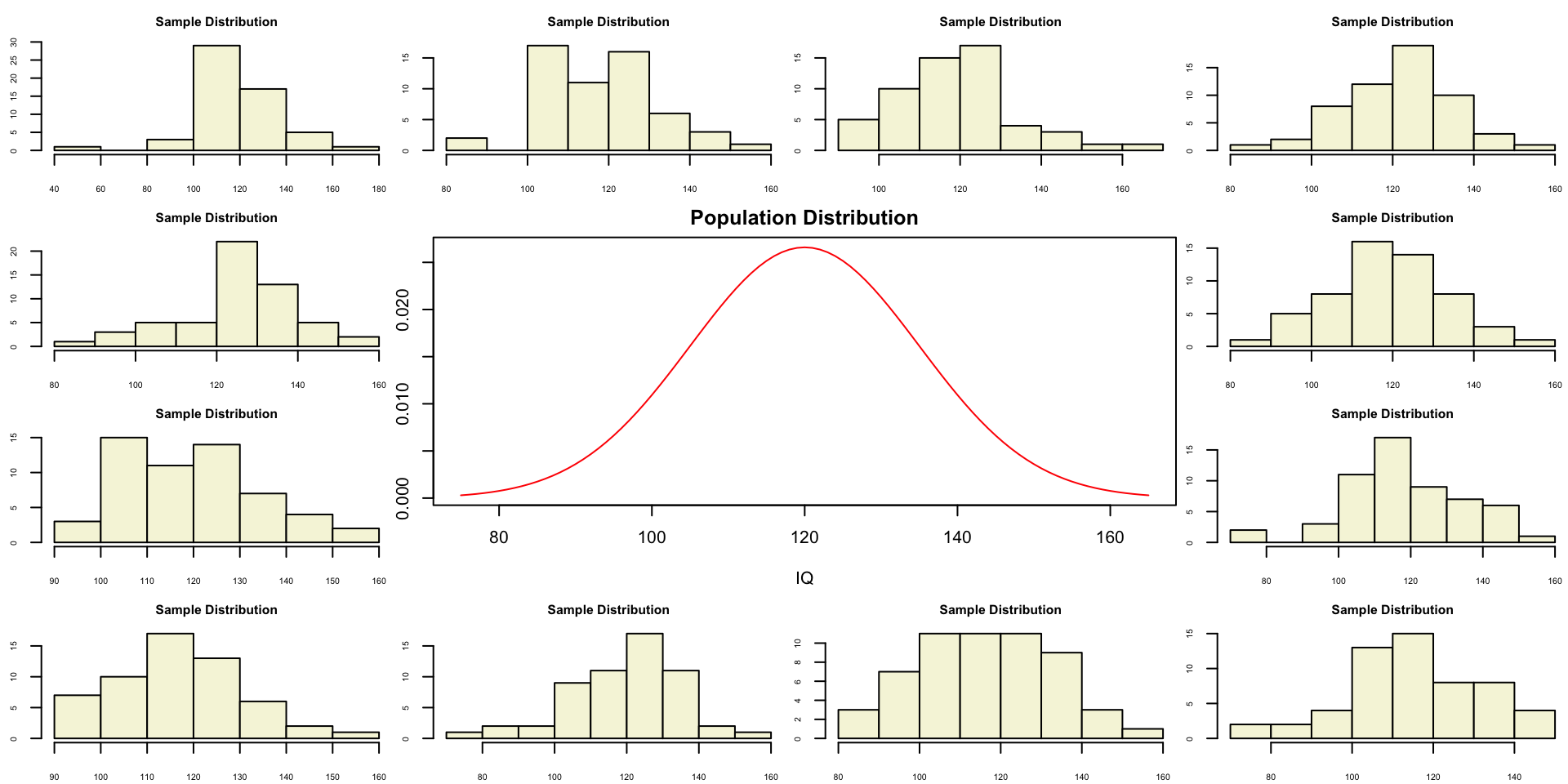
One sample
Let’s take a larger sample from our normal population.
[1] 125.38159 131.87150 97.91258 106.65761 128.79834 130.37589 104.12035
[8] 137.92415 135.05426 136.38486 143.56131 110.19591 111.06758 81.15490
[15] 124.67001 137.63382 115.79382 131.16588 122.68704 124.44491 121.53545
[22] 134.25584 121.45674 132.00408 139.55906 98.17081 121.98904 122.04234
[29] 118.85838 136.76335 142.98176 107.43160 115.22124 137.70291 131.19283
[36] 105.44568 131.72974 107.19139 130.45036 116.90866 115.49826 123.98368
[43] 120.42300 114.66301 114.37692 116.56588 112.17237 102.97537 130.09115
[50] 137.89815 104.97558 150.87956 95.52687 143.39545 114.49853 121.09488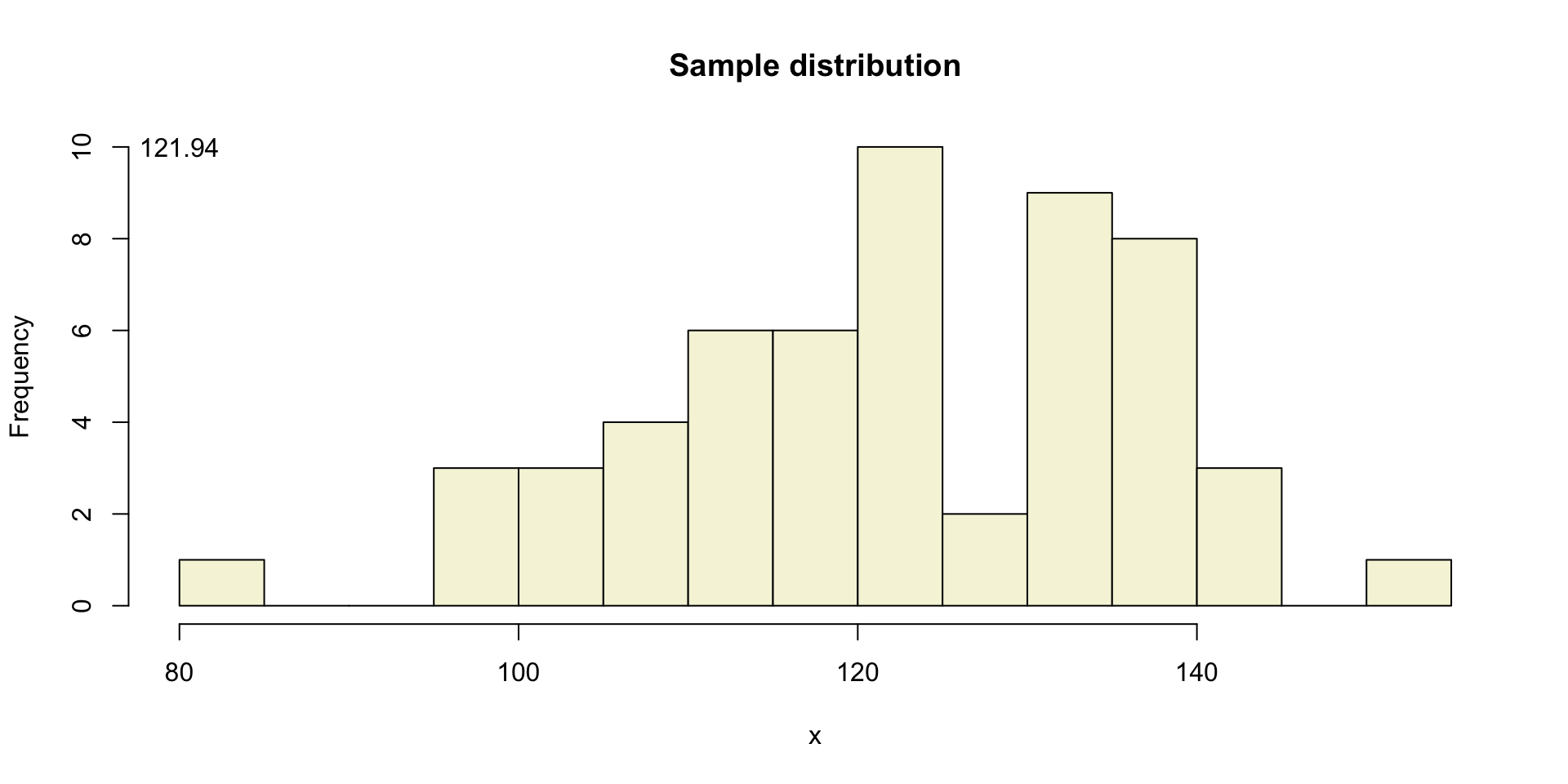
More samples
let’s take more samples.
Mean and SE for all samples
mean.x.values se.x.values
[1,] 118.9136 2.025850
[2,] 118.6910 1.900806
[3,] 121.9166 2.080805
[4,] 119.9850 2.336038
[5,] 119.8122 1.781885
[6,] 121.7780 2.006616 mean.x.values se.x.values
[995,] 118.6369 2.270611
[996,] 120.8203 1.729008
[997,] 122.0699 1.850029
[998,] 122.4615 2.048059
[999,] 119.8978 2.042032
[1000,] 121.0900 1.709775Sampling distribution
of the mean
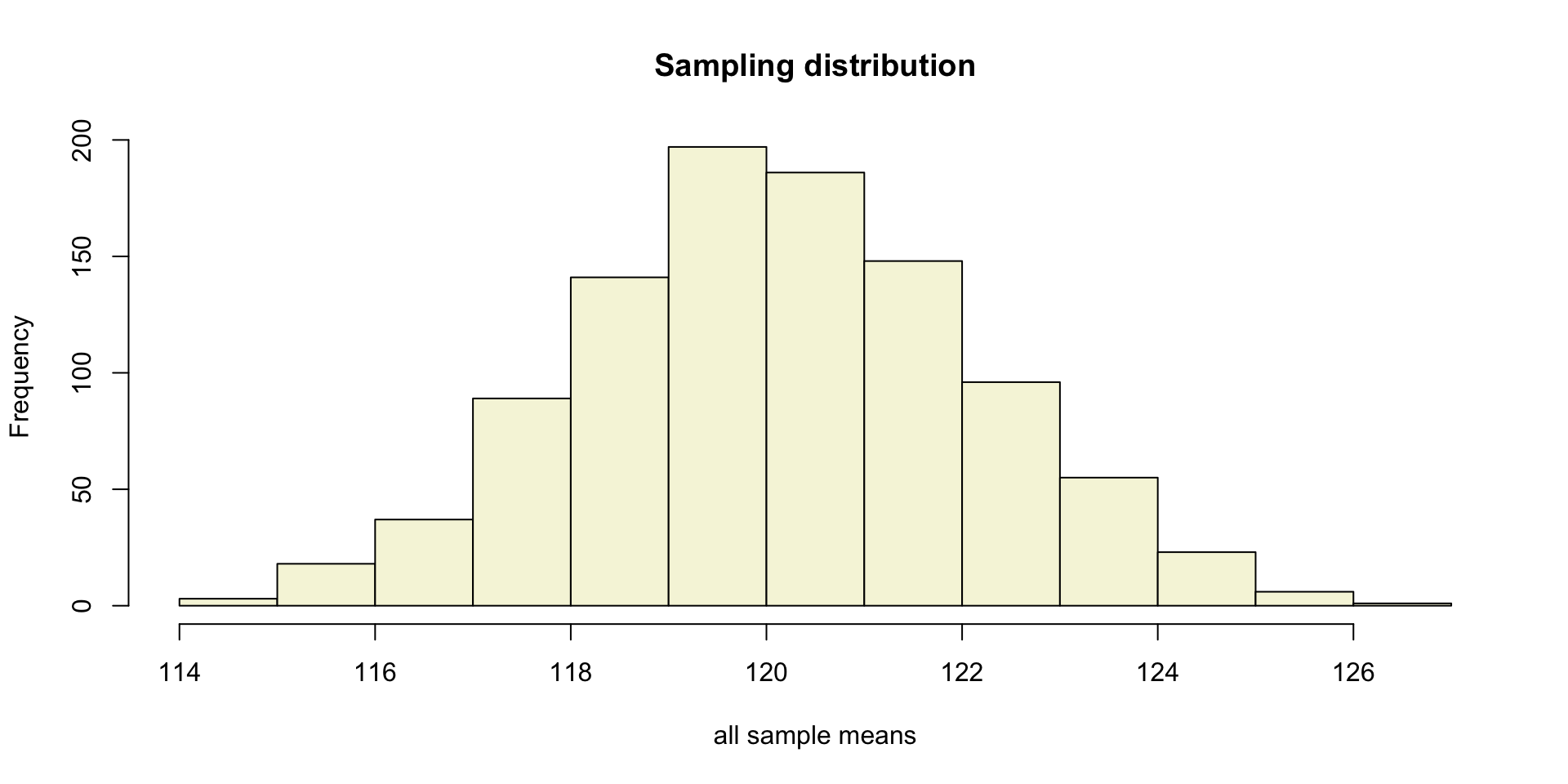
T-statistic
\[T_{n-1} = \frac{\bar{x}-\mu}{SE_x} = \frac{\bar{x}-\mu}{s_x / \sqrt{n}}\]
So the t-statistic represents the deviation of the sample mean \(\bar{x}\) from the population mean \(\mu\), considering the sample size, expressed as the degrees of freedom \(df = n - 1\)
T-value
\[T_{n-1} = \frac{\bar{x}-\mu}{SE_x} = \frac{\bar{x}-\mu}{s_x / \sqrt{n}}\]
Calculate t-values
\[T_{n-1} = \frac{\bar{x}-\mu}{SE_x} = \frac{\bar{x}-\mu}{s_x / \sqrt{n}}\]
mean.x.values mu se.x.values t.values
[995,] 118.6369 120 2.270611 -0.60033932
[996,] 120.8203 120 1.729008 0.47445351
[997,] 122.0699 120 1.850029 1.11885233
[998,] 122.4615 120 2.048059 1.20187523
[999,] 119.8978 120 2.042032 -0.05004259
[1000,] 121.0900 120 1.709775 0.63749824Sampling distribution t-values
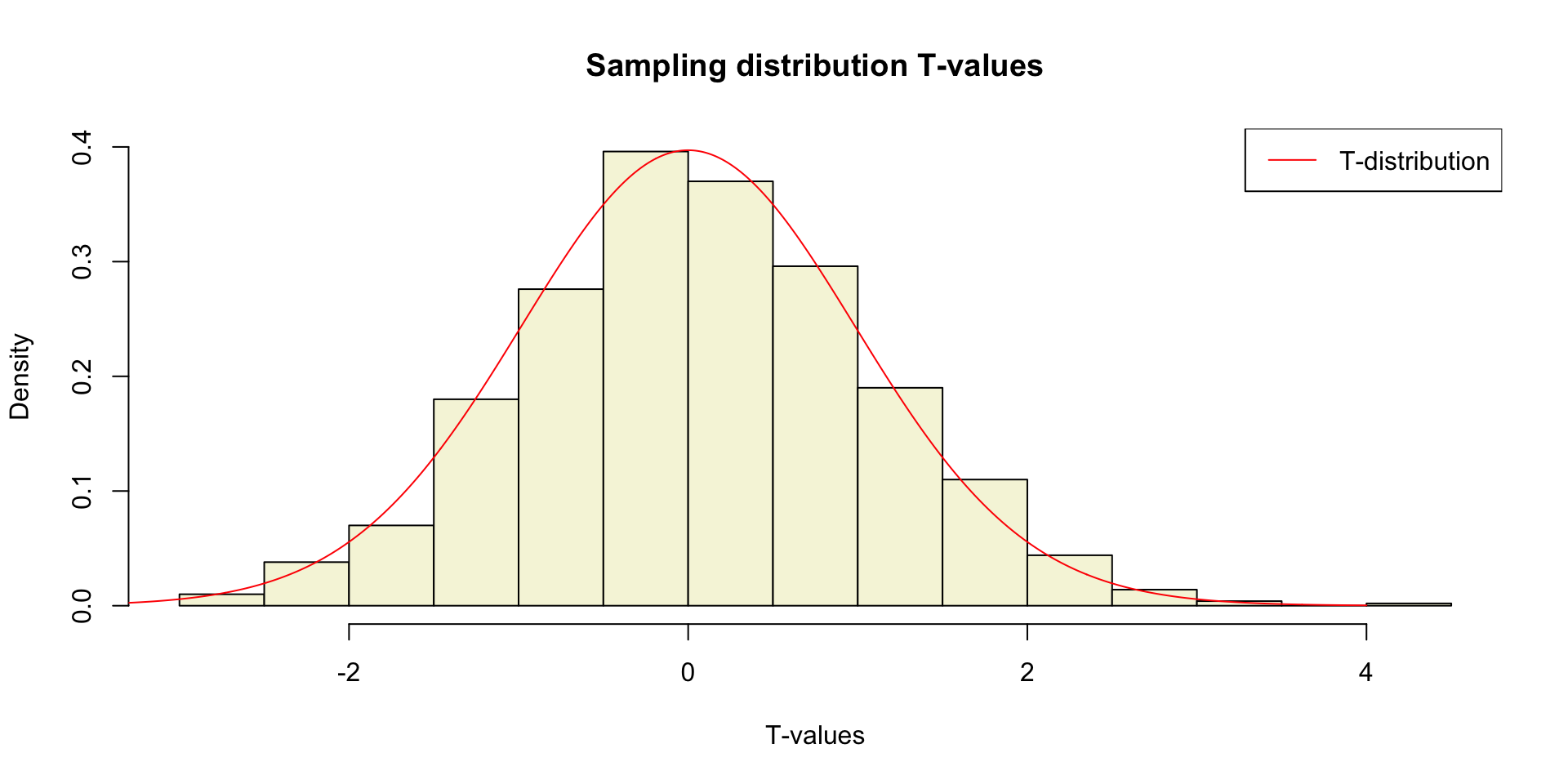
The t-distribution approximates the sampling distribution, hence the name theoretical approximation.
T-distribution
So if the population is normaly distributed (assumption of normality) the t-distribution represents the deviation of sample means from the population mean (\(\mu\)), given a certain sample size (\(df = n - 1\)).
The t-distibution therefore is different for different sample sizes and converges to a standard normal distribution if sample size is large enough.
The t-distribution is defined by the probability density function (PDF):
\[\textstyle\frac{\Gamma \left(\frac{\nu+1}{2} \right)} {\sqrt{\nu\pi}\,\Gamma \left(\frac{\nu}{2} \right)} \left(1+\frac{x^2}{\nu} \right)^{-\frac{\nu+1}{2}}\!\]
where \(\nu\) is the number of degrees of freedom and \(\Gamma\) is the gamma function (Wikipedia, 2024).
Warning
Formula not exam material
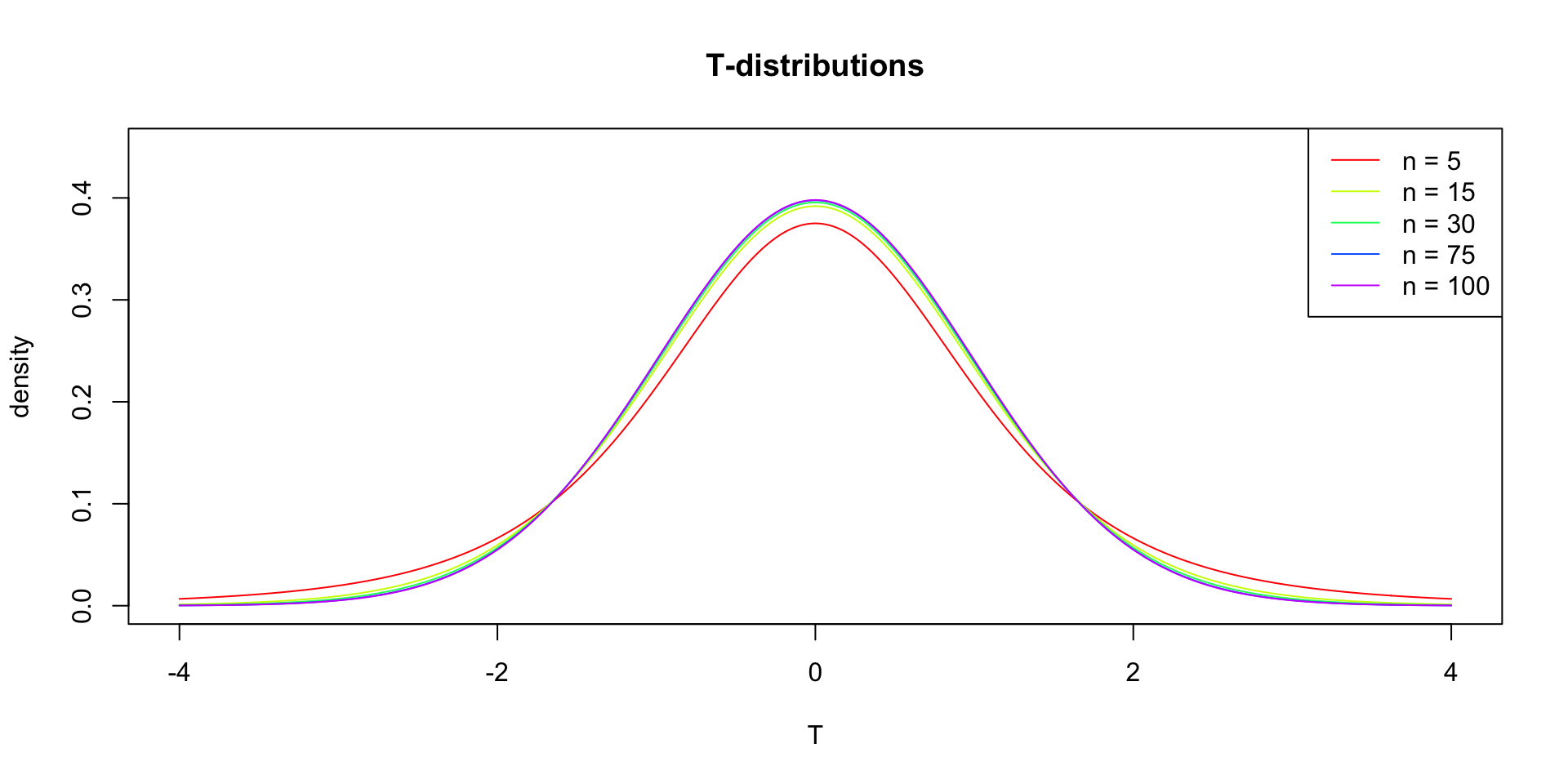
End
Contact
References
- Distribution illustration generated with DALL-E by OpenAI

Statistical Reasoning 2025-2026
